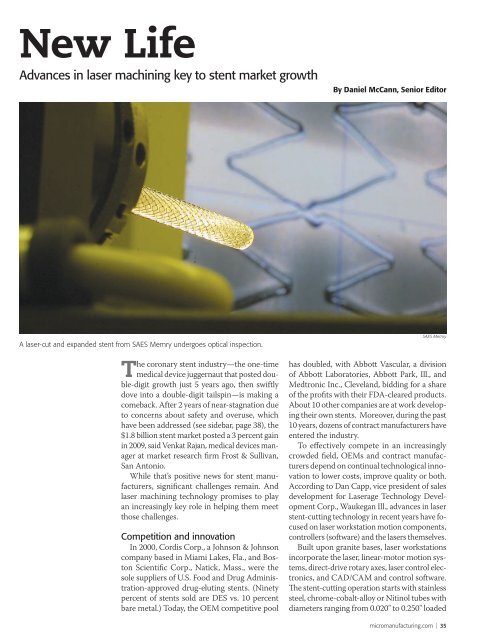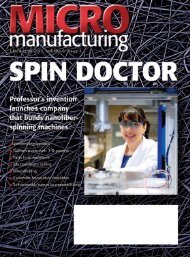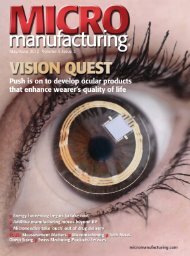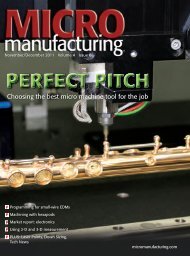Click here to view as PDF - MICROmanufacturing
Click here to view as PDF - MICROmanufacturing
Click here to view as PDF - MICROmanufacturing
You also want an ePaper? Increase the reach of your titles
YUMPU automatically turns print PDFs into web optimized ePapers that Google loves.
New Life<br />
Advances in l<strong>as</strong>er machining key <strong>to</strong> stent market growth<br />
By Daniel McCann, Senior Edi<strong>to</strong>r<br />
A l<strong>as</strong>er-cut and expanded stent from SAES Memry undergoes optical inspection.<br />
The coronary stent industry—the one-time<br />
medical device juggernaut that posted double-digit<br />
growth just 5 years ago, then swiftly<br />
dove in<strong>to</strong> a double-digit tailspin—is making a<br />
comeback. After 2 years of near-stagnation due<br />
<strong>to</strong> concerns about safety and overuse, which<br />
have been addressed (see sidebar, page 38), the<br />
$1.8 billion stent market posted a 3 percent gain<br />
in 2009, said Venkat Rajan, medical devices manager<br />
at market research firm Frost & Sullivan,<br />
San An<strong>to</strong>nio.<br />
While that’s positive news for stent manufacturers,<br />
significant challenges remain. And<br />
l<strong>as</strong>er machining technology promises <strong>to</strong> play<br />
an incre<strong>as</strong>ingly key role in helping them meet<br />
those challenges.<br />
Competition and innovation<br />
In 2000, Cordis Corp., a Johnson & Johnson<br />
company b<strong>as</strong>ed in Miami Lakes, Fla., and Bos<strong>to</strong>n<br />
Scientific Corp., Natick, M<strong>as</strong>s., were the<br />
sole suppliers of U.S. Food and Drug Administration-approved<br />
drug-eluting stents. (Ninety<br />
percent of stents sold are DES vs. 10 percent<br />
bare metal.) Today, the OEM competitive pool<br />
SAES Memry<br />
h<strong>as</strong> doubled, with Abbott V<strong>as</strong>cular, a division<br />
of Abbott Labora<strong>to</strong>ries, Abbott Park, Ill., and<br />
Medtronic Inc., Cleveland, bidding for a share<br />
of the profits with their FDA-cleared products.<br />
About 10 other companies are at work developing<br />
their own stents. Moreover, during the p<strong>as</strong>t<br />
10 years, dozens of contract manufacturers have<br />
entered the industry.<br />
To effectively compete in an incre<strong>as</strong>ingly<br />
crowded field, OEMs and contract manufacturers<br />
depend on continual technological innovation<br />
<strong>to</strong> lower costs, improve quality or both.<br />
According <strong>to</strong> Dan Capp, vice president of sales<br />
development for L<strong>as</strong>erage Technology Development<br />
Corp., Waukegan Ill., advances in l<strong>as</strong>er<br />
stent-cutting technology in recent years have focused<br />
on l<strong>as</strong>er workstation motion components,<br />
controllers (software) and the l<strong>as</strong>ers themselves.<br />
Built upon granite b<strong>as</strong>es, l<strong>as</strong>er workstations<br />
incorporate the l<strong>as</strong>er, linear-mo<strong>to</strong>r motion systems,<br />
direct-drive rotary axes, l<strong>as</strong>er control electronics,<br />
and CAD/CAM and control software.<br />
The stent-cutting operation starts with stainless<br />
steel, chrome-cobalt-alloy or Nitinol tubes with<br />
diameters ranging from 0.020" <strong>to</strong> 0.250" loaded<br />
micromanufacturing.com | 35















